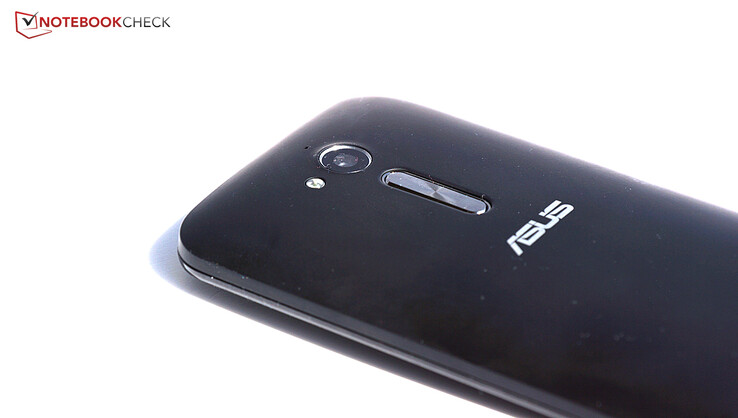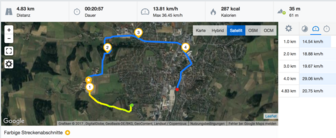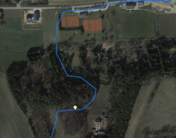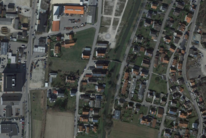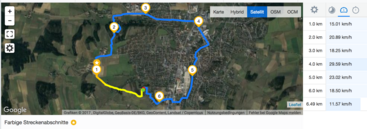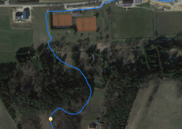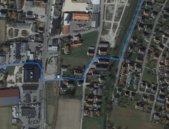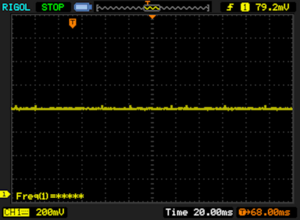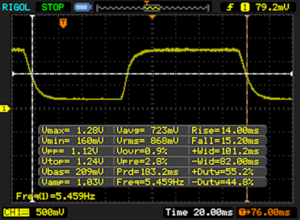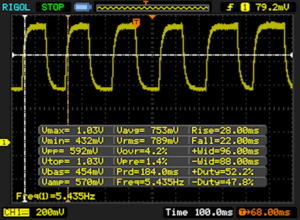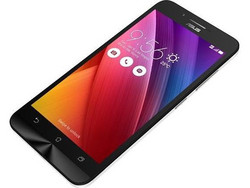华硕 ZenFone Go 智能手机简短评测
» Notebookcheck多媒体笔记本电脑Top 10排名
» Notebookcheck游戏笔记本电脑Top 10排名
» Notebookcheck低价办公/商务笔记本电脑Top 10排名
» Notebookcheck高端办公/商务笔记本电脑Top 10排名
» Notebookcheck工作站笔记本电脑Top 10排名
» Notebookcheck亚笔记本电脑Top 10排名
» Notebookcheck超级本产品Top 10排名
» Notebookcheck变形本产品Top 10排名
» Notebookcheck平板电脑Top 10排名
» Notebookcheck智能手机Top 10排名
» Notebookcheck评测过最出色的笔记本电脑屏幕
» Notebookcheck售价500欧元以下笔记本电脑Top 10排名
» Notebookcheck售价300欧元以下笔记本电脑Top 10排名
| Networking | |
| iperf3 transmit AX12 | |
| Asus Zenfone Go ZB500KL | |
| Huawei P8 lite 2017 | |
| LG X Power K220 | |
| Lenovo K6 | |
| iperf3 receive AX12 | |
| Asus Zenfone Go ZB500KL | |
| Huawei P8 lite 2017 | |
| Lenovo K6 | |
| LG X Power K220 | |
| |||||||||||||||||||||||||
Brightness Distribution: 84 %
Contrast: 1093:1 (Black: 0.42 cd/m²)
ΔE ColorChecker Calman: 4.5 | ∀{0.5-29.43 Ø4.78}
ΔE Greyscale Calman: 6.5 | ∀{0.09-98 Ø5}
96.23% sRGB (Calman 2D)
Gamma: 2.22
CCT: 7791 K
| Asus Zenfone Go ZB500KL IPS, 1280x720, 5" | LG X Power K220 IPS, 1280x720, 5.3" | Wiko U Feel IPS, 1280x720, 5" | Lenovo K6 IPS, 1920x1080, 5" | Huawei P8 lite 2017 IPS, 1920x1080, 5.2" | |
|---|---|---|---|---|---|
| Screen | -11% | 14% | 5% | 9% | |
| Brightness middle (cd/m²) | 459 | 381 -17% | 500 9% | 470 2% | 575 25% |
| Brightness (cd/m²) | 452 | 352 -22% | 485 7% | 461 2% | 559 24% |
| Brightness Distribution (%) | 84 | 85 1% | 83 -1% | 88 5% | 91 8% |
| Black Level * (cd/m²) | 0.42 | 0.2 52% | 0.22 48% | 0.38 10% | 0.39 7% |
| Contrast (:1) | 1093 | 1905 74% | 2273 108% | 1237 13% | 1474 35% |
| Colorchecker dE 2000 * | 4.5 | 7.3 -62% | 6.3 -40% | 5.2 -16% | 5.2 -16% |
| Colorchecker dE 2000 max. * | 10.6 | 21.2 -100% | 14.4 -36% | 9.5 10% | 10.3 3% |
| Greyscale dE 2000 * | 6.5 | 7.4 -14% | 5.2 20% | 5.6 14% | 7.2 -11% |
| Gamma | 2.22 99% | 2.26 97% | 2.17 101% | 2.24 98% | 2.4 92% |
| CCT | 7791 83% | 8417 77% | 7536 86% | 7924 82% | 7224 90% |
* ... smaller is better
Screen Flickering / PWM (Pulse-Width Modulation)
| Screen flickering / PWM not detected | |||
In comparison: 53 % of all tested devices do not use PWM to dim the display. If PWM was detected, an average of 8101 (minimum: 5 - maximum: 343500) Hz was measured. | |||
Display Response Times
| ↔ Response Time Black to White | ||
|---|---|---|
| 29 ms ... rise ↗ and fall ↘ combined | ↗ 14 ms rise | |
| ↘ 15 ms fall | ||
| The screen shows relatively slow response rates in our tests and may be too slow for gamers. In comparison, all tested devices range from 0.1 (minimum) to 240 (maximum) ms. » 76 % of all devices are better. This means that the measured response time is worse than the average of all tested devices (20.2 ms). | ||
| ↔ Response Time 50% Grey to 80% Grey | ||
| 50 ms ... rise ↗ and fall ↘ combined | ↗ 28 ms rise | |
| ↘ 22 ms fall | ||
| The screen shows slow response rates in our tests and will be unsatisfactory for gamers. In comparison, all tested devices range from 0.165 (minimum) to 636 (maximum) ms. » 85 % of all devices are better. This means that the measured response time is worse than the average of all tested devices (31.6 ms). | ||
| AnTuTu v6 - Total Score (sort by value) | |
| Asus Zenfone Go ZB500KL | |
| LG X Power K220 | |
| Wiko U Feel | |
| Lenovo K6 | |
| Huawei P8 lite 2017 | |
| Geekbench 4.0 | |
| 64 Bit Single-Core Score (sort by value) | |
| Asus Zenfone Go ZB500KL | |
| LG X Power K220 | |
| Lenovo K6 | |
| Huawei P8 lite 2017 | |
| 64 Bit Multi-Core Score (sort by value) | |
| Asus Zenfone Go ZB500KL | |
| LG X Power K220 | |
| Lenovo K6 | |
| Huawei P8 lite 2017 | |
| 3DMark | |
| 1280x720 offscreen Ice Storm Unlimited Score (sort by value) | |
| Asus Zenfone Go ZB500KL | |
| LG X Power K220 | |
| Wiko U Feel | |
| Lenovo K6 | |
| Huawei P8 lite 2017 | |
| 1280x720 offscreen Ice Storm Unlimited Graphics Score (sort by value) | |
| Asus Zenfone Go ZB500KL | |
| LG X Power K220 | |
| Wiko U Feel | |
| Lenovo K6 | |
| Huawei P8 lite 2017 | |
| 1280x720 offscreen Ice Storm Unlimited Physics (sort by value) | |
| Asus Zenfone Go ZB500KL | |
| LG X Power K220 | |
| Wiko U Feel | |
| Lenovo K6 | |
| Huawei P8 lite 2017 | |
| 2560x1440 Sling Shot OpenGL ES 3.0 (sort by value) | |
| Asus Zenfone Go ZB500KL | |
| LG X Power K220 | |
| Wiko U Feel | |
| Lenovo K6 | |
| Huawei P8 lite 2017 | |
| 2560x1440 Sling Shot OpenGL ES 3.0 Graphics (sort by value) | |
| Asus Zenfone Go ZB500KL | |
| LG X Power K220 | |
| Wiko U Feel | |
| Lenovo K6 | |
| Huawei P8 lite 2017 | |
| 2560x1440 Sling Shot OpenGL ES 3.0 Physics (sort by value) | |
| Asus Zenfone Go ZB500KL | |
| LG X Power K220 | |
| Wiko U Feel | |
| Lenovo K6 | |
| Huawei P8 lite 2017 | |
| GFXBench (DX / GLBenchmark) 2.7 | |
| T-Rex Onscreen (sort by value) | |
| Asus Zenfone Go ZB500KL | |
| LG X Power K220 | |
| Wiko U Feel | |
| Lenovo K6 | |
| Huawei P8 lite 2017 | |
| 1920x1080 T-Rex Offscreen (sort by value) | |
| Asus Zenfone Go ZB500KL | |
| LG X Power K220 | |
| Wiko U Feel | |
| Lenovo K6 | |
| Huawei P8 lite 2017 | |
| GFXBench 3.0 | |
| on screen Manhattan Onscreen OGL (sort by value) | |
| Asus Zenfone Go ZB500KL | |
| LG X Power K220 | |
| Wiko U Feel | |
| Lenovo K6 | |
| Huawei P8 lite 2017 | |
| 1920x1080 1080p Manhattan Offscreen (sort by value) | |
| Asus Zenfone Go ZB500KL | |
| LG X Power K220 | |
| Wiko U Feel | |
| Lenovo K6 | |
| Huawei P8 lite 2017 | |
| PCMark for Android - Work performance score (sort by value) | |
| Asus Zenfone Go ZB500KL | |
| LG X Power K220 | |
| Wiko U Feel | |
| Lenovo K6 | |
| Huawei P8 lite 2017 | |
| Octane V2 - Total Score (sort by value) | |
| Asus Zenfone Go ZB500KL | |
| LG X Power K220 | |
| Wiko U Feel | |
| Lenovo K6 | |
| Huawei P8 lite 2017 | |
| JetStream 1.1 - Total Score (sort by value) | |
| Asus Zenfone Go ZB500KL | |
| LG X Power K220 | |
| Wiko U Feel | |
| Lenovo K6 | |
| Huawei P8 lite 2017 | |
| Mozilla Kraken 1.1 - Total (sort by value) | |
| Asus Zenfone Go ZB500KL | |
| LG X Power K220 | |
| Wiko U Feel | |
| Lenovo K6 | |
| Huawei P8 lite 2017 | |
* ... smaller is better
| AndroBench 3-5 | |
| Sequential Read 256KB (sort by value) | |
| Asus Zenfone Go ZB500KL | |
| LG X Power K220 | |
| Wiko U Feel | |
| Lenovo K6 | |
| Huawei P8 lite 2017 | |
| Sequential Write 256KB (sort by value) | |
| Asus Zenfone Go ZB500KL | |
| LG X Power K220 | |
| Wiko U Feel | |
| Lenovo K6 | |
| Huawei P8 lite 2017 | |
| Random Read 4KB (sort by value) | |
| Asus Zenfone Go ZB500KL | |
| LG X Power K220 | |
| Wiko U Feel | |
| Lenovo K6 | |
| Huawei P8 lite 2017 | |
| Random Write 4KB (sort by value) | |
| Asus Zenfone Go ZB500KL | |
| LG X Power K220 | |
| Wiko U Feel | |
| Lenovo K6 | |
| Huawei P8 lite 2017 | |
| Sequential Read 256KB SDCard (sort by value) | |
| Asus Zenfone Go ZB500KL | |
| LG X Power K220 | |
| Wiko U Feel | |
| Lenovo K6 | |
| Huawei P8 lite 2017 | |
| Sequential Write 256KB SDCard (sort by value) | |
| Asus Zenfone Go ZB500KL | |
| LG X Power K220 | |
| Wiko U Feel | |
| Lenovo K6 | |
| Huawei P8 lite 2017 | |
(+) The maximum temperature on the upper side is 38 °C / 100 F, compared to the average of 35.2 °C / 95 F, ranging from 21.9 to 247 °C for the class Smartphone.
(+) The bottom heats up to a maximum of 35.3 °C / 96 F, compared to the average of 34 °C / 93 F
(+) In idle usage, the average temperature for the upper side is 31.5 °C / 89 F, compared to the device average of 32.9 °C / 91 F.
Asus Zenfone Go ZB500KL audio analysis
(±) | speaker loudness is average but good (78.4 dB)
Bass 100 - 315 Hz
(-) | nearly no bass - on average 28.6% lower than median
(±) | linearity of bass is average (10.2% delta to prev. frequency)
Mids 400 - 2000 Hz
(+) | balanced mids - only 4.8% away from median
(+) | mids are linear (6.1% delta to prev. frequency)
Highs 2 - 16 kHz
(+) | balanced highs - only 3.1% away from median
(+) | highs are linear (4.5% delta to prev. frequency)
Overall 100 - 16.000 Hz
(±) | linearity of overall sound is average (25.8% difference to median)
Compared to same class
» 64% of all tested devices in this class were better, 6% similar, 29% worse
» The best had a delta of 11%, average was 35%, worst was 134%
Compared to all devices tested
» 79% of all tested devices were better, 4% similar, 17% worse
» The best had a delta of 4%, average was 24%, worst was 134%
Huawei P8 lite 2017 audio analysis
(+) | speakers can play relatively loud (83.6 dB)
Bass 100 - 315 Hz
(-) | nearly no bass - on average 32.1% lower than median
(±) | linearity of bass is average (11.2% delta to prev. frequency)
Mids 400 - 2000 Hz
(+) | balanced mids - only 4% away from median
(+) | mids are linear (6.4% delta to prev. frequency)
Highs 2 - 16 kHz
(±) | higher highs - on average 7.9% higher than median
(+) | highs are linear (4.8% delta to prev. frequency)
Overall 100 - 16.000 Hz
(±) | linearity of overall sound is average (27.6% difference to median)
Compared to same class
» 72% of all tested devices in this class were better, 5% similar, 24% worse
» The best had a delta of 11%, average was 35%, worst was 134%
Compared to all devices tested
» 84% of all tested devices were better, 3% similar, 13% worse
» The best had a delta of 4%, average was 24%, worst was 134%
| Off / Standby | |
| Idle | |
| Load |
|
Key:
min: | |
| Asus Zenfone Go ZB500KL 2600 mAh | LG X Power K220 4100 mAh | Wiko U Feel 2500 mAh | Lenovo K6 3000 mAh | Huawei P8 lite 2017 3000 mAh | |
|---|---|---|---|---|---|
| Power Consumption | 10% | -22% | 2% | -43% | |
| Idle Minimum * (Watt) | 0.92 | 0.64 30% | 0.82 11% | 0.65 29% | 1.44 -57% |
| Idle Average * (Watt) | 1.76 | 1.3 26% | 1.61 9% | 1.65 6% | 2.47 -40% |
| Idle Maximum * (Watt) | 1.85 | 1.34 28% | 1.8 3% | 1.67 10% | 2.58 -39% |
| Load Average * (Watt) | 3.47 | 4.18 -20% | 5.99 -73% | 3.58 -3% | 4.55 -31% |
| Load Maximum * (Watt) | 4.22 | 4.87 -15% | 6.7 -59% | 5.58 -32% | 6.3 -49% |
* ... smaller is better
| Asus Zenfone Go ZB500KL 2600 mAh | LG X Power K220 4100 mAh | Wiko U Feel 2500 mAh | Lenovo K6 3000 mAh | Huawei P8 lite 2017 3000 mAh | |
|---|---|---|---|---|---|
| Battery runtime | 54% | -3% | 22% | 5% | |
| Reader / Idle (h) | 20.4 | 27.1 33% | 22.1 8% | ||
| H.264 (h) | 10.3 | 10.6 3% | 10.7 4% | ||
| WiFi v1.3 (h) | 9.5 | 16.5 74% | 9.2 -3% | 11.9 25% | 10.1 6% |
| Load (h) | 4.6 | 6.1 33% | 5.8 26% | 4.7 2% |
Pros
Cons
ZenFone Go,是华硕旗下处于中低档的智能手机。坚固的外壳、可拆卸的电池和良好照明条件下的照相机为耳机代言。然而,用户必须在菜单中导航时相对较低的性能表现。此外,GPS模块有时会闪退,并且屏幕仅实现平均水平的对比度并且亮度不均。
在我们看来,值得高兴的是华硕通过更新向手机提供Google最新的安全补丁。但是,在这个价格范围内,不应该期望公司会提供最新操作系统的更新。屏幕相对优秀的颜色精度和良好表现也是它的优点。
ZenFone Go也有它的优点,如可拆卸电池和坚固的机壳。然而,华硕可以给它更强的性能。
总的来说,我们可以向不依赖高性能的用户推荐ZenFone Go。不过,买家应该注意到,同类产品中不乏令人印象深刻的型号,如华为 P8 lite (2017) 或 联想K6, 价格相同或略高一些。
注:本文是基于完整评测的缩减版本,阅读完整的英文评测,请点击这里。
Asus Zenfone Go ZB500KL
- 04/03/2017 v6 (old)
Florian Wimmer




